Michael Sheehan looks at the Ferrari Supercars-Part I
All photos courtesy Michael Sheehan unless othewise noted.
Below, the evolution of a species.
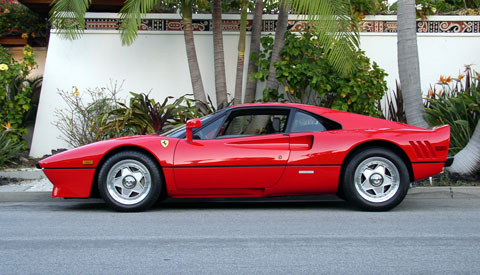
288 GTO s/n 54231
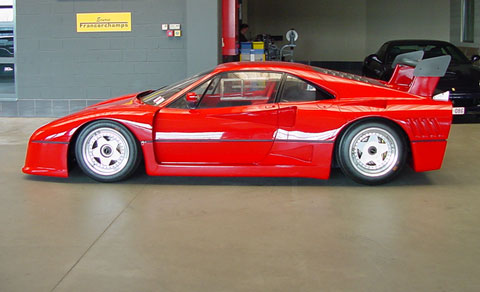
288 Evo s/n 79888
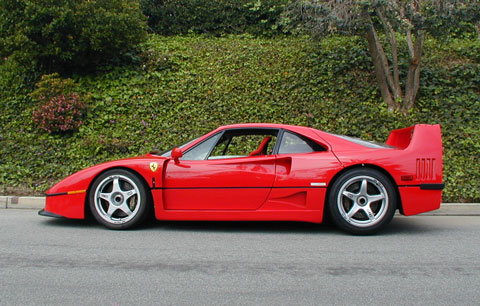
F40 s/n 90568
Before they were called Supercars
Through the 1950s and up to the mid-1960s Ferrari built a very limited series of luxurious, big-engined, custom bodied supercars, starting with a short run of only six 342 Americas,the 375 America, followed by the 410 Superamerica, the 400 Superamerica, the 500 Superfast and ending with the 365 California. These flagship Ferraris were built for Ferrari’s well heeled exclusive clients, Royalty, captains of industry and well known celebrities. The custom bodied Ferrari era ended in the late 1960s with the introduction of crash test regulations and so, through the 1970s and early 1980s Ferrari had no top-of-the-line flagship models, only high volume and high profit production models such as the stylistically bland 400i, Mondial, 512 BBi and 308s.
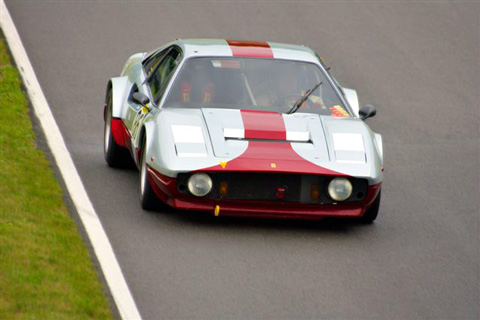
Steven Dudley racing his 308 GTB Michelotto s/n 21883 in the Shell Historics. Photo by Bruce B. Miller
Fiat realized the marketing panache of building a new breed of flagship Ferraris that shared a direct link with both their high volume production cars and with Ferraris rich racing tradition, Ferrari turned to Michelotto; the authorized Ferrari dealer for Padova, a small town only 150 miles down the road from Maranello. Michelotto had made their reputation building and race–preparing lightweight 308s for Ferrari France and multiple Italian privateers. While fewer than 20 of these lightweight 308 rally cars were built, they were very successful and extremely popular with rally fans who were thrilled to again see GT-based Ferraris in competition.
In the early 1980s Ferrari and Michelotto collaborated to build and test the prototypes for the 288 GTO, a new performance inspired flagship Supercar in the tradition of the all conquering 1962–1964 250 GTO. The 288 GTO combined both a direct visual link with the high volume 308 series and a low volume homologation model for the highly popular Group B rally series. The 288 GTO became the first in a new tradition of very exclusive and expensive Ferraris aimed at the Ferrari enthusiast that had to have (and could afford) the absolute top-of-the-line performance street Ferrari.
288 GTO; the Turbo era:
Introduced in 1984, the 288 GTO was the logical evolution of two convergent eras in racing. The F-1 Turbo era began in 1977 with the very quick but unreliable Renault RS01. During the 1977 season the 460 hp Renault RS01 easily out-powered the 410 hp Cosworth but the Renault suffered from severe turbo lag and multiple reliability problems and so the Renault RS01 failed to finish a single race during the season. By the early 1980s turbo reliability and management problems were a memory and all the front runners in F-1, such as the Ferrari F1 Tipo 126 C series, were turbo-cars. Meanwhile, the Group B rally championship was introduced in 1982, producing the fastest and most exciting Rally cars the sport has ever seen. Group B had minimal restrictions on technology, no limit on turbo boost, no minimum weight limit and only 200 cars had to be built to be homologated for Group B. Even better, 20 of those cars could be built to “Evolution” specifications. Turbos were all the rage and Ferrari joined the horsepower race!
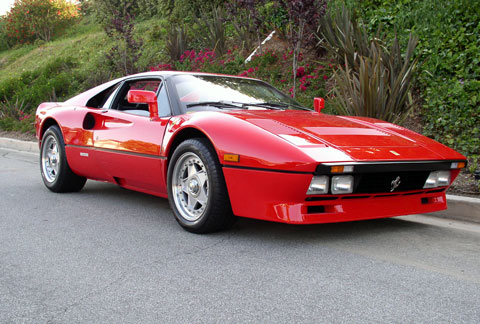
288 GTO: Only 272 built, prices from $495k to $595k.
Michelotto was commissioned to build and test the 288 GTO prototypes and to do the development work to homologate the 288 GTO as a Group B car. Michelotto was also asked to build a series of ultra-sophisticated 288 GTO race cars called the 288 GTO Evoluziones. While a total of 272 Ferrari 288 GTOs were built, only 6 Evoluziones cars were built and eventually sold to collectors such as the Sultan of Brunei or were retained by the Ferrari Factory Museum. As for racing the Evoluzione in Group B, Ferrari certainly did not want to be beaten by Audi, Peugeot or Lancia and the new Group B winning Audi Quattro; the Peugeot 205 and the Lancia Delta all featured 4-wheel drive, making the 288 Evoluzione obsolete before the first race! Additionally the cost of running in Group B climbed astronomically, and the Group B cars were so fast that the occasional “off” was sometimes fatal. Group B was cancelled at the end of 1986. It is interesting to note that 288 Evo s/n 70025 became the development car for the F40 series, with many of the styling cues from the 288 Evo finding their way to the F40. Evo s/n 70205 now lives in the Ferrari Galleria, the Factories Museum in Maranello.
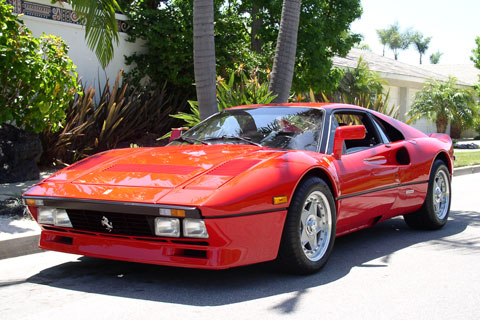
From any angle, the 288 GTO was more attractive than the 308 GTB.
The 288 GTO shared the overall styling, the 4-valve V-8 engine and the basic frame layout with the 308 GTB. Fitted with a fiberglass and carbon fiber body, the 288 GTO looks like a 308 GTB on serious steroids. In street trim the 288 GTOs twin-turbocharged V-8 produces a massive 400 bhp with 365 ft/lbs torque at 3,800 rpm. The 0 to 60 mph mark comes up in under five seconds and top speed is 190 miles per hour, making the 288 GTO the fastest production car in the world when debuted in 1984. Even better, a 288 GTO is a perfectly tractable road car, with the option of user friendly P/W, A/C and air conditioning.
Each 288 GTO came with a set of tools, a jack kit and a set of books that included an owner’s manual, a parts book, a list of dealers and a warranty card, all in a leather pouch.
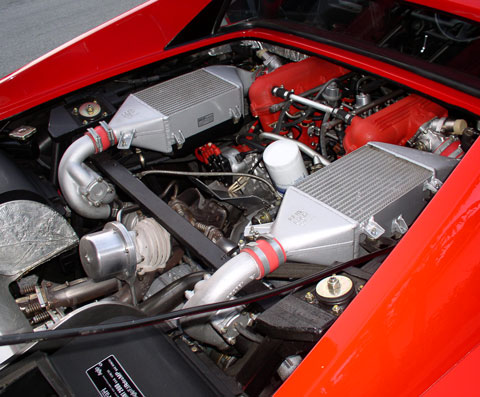
Twin-turbocharged V-8 produces a massive 400 bhp with 365 ft/lbs torque at 3,800 rpm. The engine was turned to a longitudinal position from the transverse-engined 308 GTB.
Problem areas are minimal with cam–belt tensioner bearings that tend to tighten up over time causing the outside of the cam belt to scuff and gall against the tensioner leading to belt failure. The 288 GTOs magnesium bellhousing emits gases that will cause the clutch hydraulics to fail. This can be resolved by vacuum impregnating the bellhousing to seal it’s porosity, and a rebuild of the hydraulics. Additionally, most 288 GTOs are low mileage and when used are run hard and put away wet. A detailed pre-purchase inspection with compression and leakdown are mandatory! Last but not least, 288 GTOs are now 25 years old and every rubber component, from water hoses to suspension bushings, are long past their due date for replacement, regardless of miles.
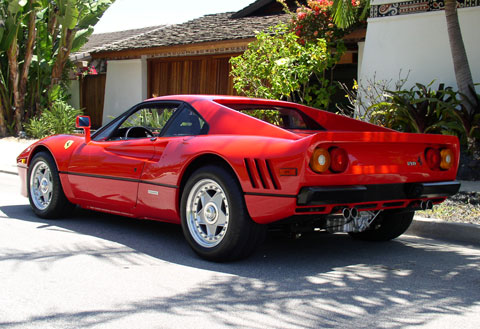
Shark vents on the 288 GTO were carried over to the new F40.
All 288 GTOs were Euro models, so all US bound 288s had to go through the EPA and DOT process. While 288 GTOs are usually less outside the US, today’s cost to EPA and DOT a GTO is a prohibitive $40k to 50k.
A modest $75k when new, by the late 1980s 288 GTOs sold for well over $1m with this author selling about half-a-dozen to Japan in the $1,1m range. By the mid 1990’s they had dropped to the $225k range and today trade in the $500k to 600k range! As for the ultra rare 288 GTO Evoluziones, only one has traded hands in a decade, and the empirical guess is that it traded hands at some number around $1m.
Ferrari F40; faster is better:
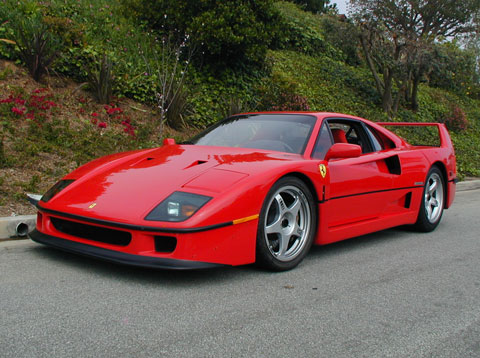
Ferrari claimed 201 mph top speed for the F40.
The F40 was the last car to be introduced by Enzo Ferrari, in June of 1987, in Maranello. Named in honor of 40 years of Ferrari race and road cars, Ferrari’s latest super car was an engineering tour-de-force derived from the 288 GTO Evoluzione, combining raw-edged radical styling with what-was-then-state of the art engine, body and chassis design.
Cost-was-no-object engineering produced a carbon fiber and Kevlar body with a steel space-frame and a twin-turbo intercooled 478 hp V8 engine. Formula one-sized wheels, tires and a wind tunnel tested body gave a claimed 201 mph top speed and 0 to 60 times in the low 4-second range. Once again Ferrari raised the performance bar as the F40 replaced the 288 GTO to claim the title of the fastest production car on the planet. Even with its staggering performance, an F40 is well mannered, air conditioned and tractable enough to drive around town. When introduced it was implied that the F40 would be a limited production model, but with 1447 cars built, F40 production exceeded every Ferrari model built before it except the Testarossas, Dinos and 308 series cars. As a comparison, there were 1,291 Daytona’s, 350 275 GTB/4s and only 272 Ferrari 288 GTOs produced.
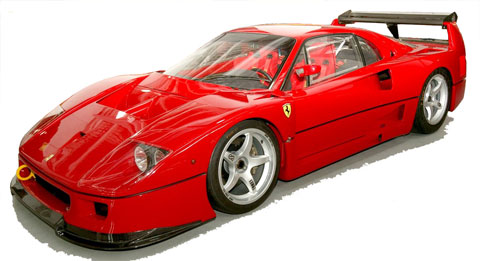
Michelotto combined with F40 equaled the F40 LM GTE.
With the introduction of the F40, Ferrari decided to re-enter GT racing and had Michelotto build a series of nineteen ultra-high-performance F40 LMs for America’s IMSA and Europe’s GTC series. Michelotto also built seven F40 GTs for the Italian Supercar Championship and another six F40 LM GTEs for the BPR GT series. The F40 LMs were the first to race with five podium finishes over eleven starts in the 1989-1990 IMSA GTO Series. This author was then racing an IMSA GTO spec Chevrolet Camaro in the IMSA GTO series and was at Laguna Seca in October, 1989, when no less than Jean Alesi introduced F40 LM s/n 79890, finishing 3rd. Alas the author was a DNF when taken out by another spinning car. F40 GT s/n 80742 won the Italian GT series in 1993 and the F40 LM GTEs had four wins and thirteen podium finishes during the BPR series. All were competitive, out-of-the-box, and could have been even more competitive, but all lacked any real Factory support or development. Any of these ultra rare and ultra fast Ferraris is the ultimate addition to the collector who wants to occasionally track his Ferraris!
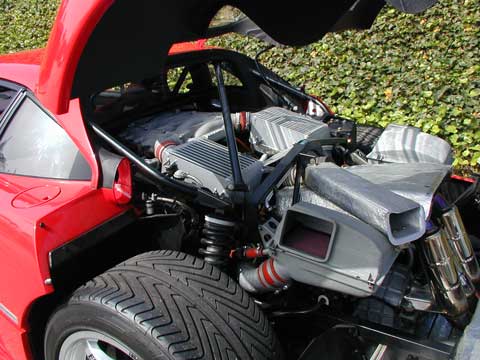
F40 and the 288 GTO both share more-or-less common mechanicals. Under the scoops and intercoolers there is a V8.
Like the 288 GTO and other production Ferraris of its era, the F40 came with a set of tools, a jack kit and a set of books that included an owner’s manual, a parts book, a list of dealers and a warranty card, all in a leather pouch. A three piece fitted luggage set by Mauro Schedoni of Modena was an option at about $1,250.
Introduced at the height of the 1980’s price frenzy, the rampant speculation on the F40 epitomized the era. Despite a list price of around $250-300k, the first few F40s sold for over $1 million. Then prices dropped, bottoming out in the late 1990s at approximately $250k to $275k, before climbing to today’s $425k to $525k level for a low–mileage example.
F40 LMs, F40 GTs and F40 LM GTEs sell in the $800k to $1m range, depending upon their histories, spares and condition.
Potential mechanical and maintenance problem on the F40 mirror those on the 288 GTO as both share more-or-less common mechanicals.
As for importing a Euro version of the F40, one only needs to compare the major frame differences shown in a Euro F40 parts book versus a US F40 parts book to see that the frame modifications to make a Euro F40 US legal would be staggering.
Next: Discussing the F50 and Enzo Supercars
As far as I am concerned, Mike Sheehan’s articles are one of the best parts of Sports Car Market magazine. So, needless to say, it is great to see him here!
We read, “Ferraris were built for Ferrari’s well healed exclusive clients…” I didn’t know you had to be sick before you could buy a Ferrari. The writer was looking for “well-heeled,” meaning rich enough to have shoes in good repair.